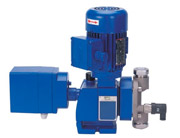The first step to ensuring trouble-free operation from your metering pump is seeking professional equipment recommendations prior to purchase and installation. Your installer can supply custom parts of the system, and coordinate the final installation. A typical installation process may include plant layouts and drawings, mechanical schematics, manuals, and even field training if needed.

But even with proper installation and maintenance, the kind of work done by a metering pump will result in gradual wear, breakdown, and emergency repair. Some of the common problems include:
- Loss of chemical residue – Can be caused by using a very low pump setting, scaling at the point of injection, or allowing the solution container to run dry.
- Excess chemical – Can be caused by using a very high pump setting, using a very rich chemical in the solution tank, or siphoning of chemical into the well or main line.
- Leakage at tubing connection – Usually due to worn tube ends or chemical attacks.
- Failure to pump – This problem can be caused by many things, like a leak in the suction side of the pump, low setting on the pump, a ruptured diaphragm, low solution level, the valve seats not sealing, a cracked or broken pump head, the pump head containing air or chlorine gas, a voltage drop, or a breakdown or malfunction of the wiring and electronic control board.
- Pump losing prime or refusing to prime – This can be caused by a dirty check valve, ball checks not sealing properly, excess pressure at discharge, or excess suction lift height.
With proper training, most in-house technicians can prevent these problems from arising through routine maintenance. That said, professional service and repair work is recommended at regular intervals to replace worn parts and/or rebuild and upgrade the system if need be. If done right, rebuilding your metering pump should carry the same warranty as a brand new one but without the extra cost.
